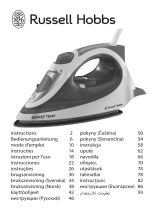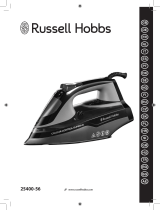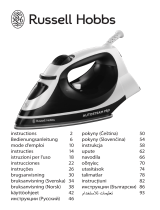ENGLISH
2 Wipe scale and any other deposits off the soleplate with a damp
cloth and a non-abrasive (liquid) cleaner.
To keep the soleplate smooth, you should avoid hard contact with metal
objects. Never use a scouring pad, vinegar or other chemicals to clean
the soleplate.
3 Clean the upper part of the appliance with a damp cloth.
4 Regularly rinse the water tank with water. Empty the water tank
after cleaning.
Calc-Clean function
Use the Calc-Clean function once every two weeks. If the water in your
area is very hard (i.e. when flakes come out of the soleplate during ironing),
the Calc-Clean function should be used more frequently.
1 Set the steam control to position O.
2 Set the temperature dial to MAX.
3 Fill the water tank to the maximum level.
Do not pour vinegar or other descaling agents into the water tank..
4 Put the plug in the wall socket.
5 Unplug the iron when the temperature light has gone out.
6 Hold the iron over the sink and set the steam control to the
Calc-Clean position x (fig. 9).
7 Pull the steam control slightly upwards and gently shake the iron
until all water in the tank has been used up.
Steam and boiling water will come out of the soleplate. Scale (if any) will
be flushed out.
8 After having used the Calc-Clean function, press the steam control
back to its original position and set it to position O.
Repeat the Calc-Clean process if the water coming out of the iron still
contains scale particles.
After the Calc-Clean process
1 Connect the iron to the mains to let the soleplate dry.
2 Unplug the iron when the temperature light has gone out.
3 Move the iron gently over a piece of used cloth to remove any
water stains that may have formed on the soleplate.
4 Let the iron cool down before you store it.
Cleaning the steam control needle
1 Pull the steam control out of the appliance (fig. 10).
2 Use vinegar to remove scale, if any, from the needle (fig. 11).
Do not bend or damage the steam control needle.
3 Reinsert the steam control needle by placing the point of the needle
exactly in the centre of the hole and by fitting the small projection
on the side of the needle into the slot (fig. 12).
4 Set the steam control to position O.
Storage
.
1 Make sure the appliance is unplugged and set the steam control to
position O.
2 Empty the water tank (fig. 13).
3 Wind the mains cord around the cord storage facility.
4 Store the iron on its heel in a safe and dry place (fig. 14).
Environment
.
◗ Do not throw the appliance away with the normal household waste
at the end of its life, but hand it in at an official collection point for
recycling. By doing this you will help to preserve the environment
(fig. 15).
Guarantee & service
.
If you need information or if you have a problem, please visit the Philips
website at www.philips.com or contact the Philips Customer Care Centre
in your country (you will find its phone number in the worldwide guaran-
tee leaflet). If there is no Customer Care Centre in your country, turn to
your local Philips dealer or contact the Service Department of Philips
Domestic Appliances and Personal Care BV.
Troubleshooting
.
This chapter summarises the most common problems you could encounter
with your iron. Please read the different sections for more details. If you
are unable to solve the problem, contact the Customer Care Centre in
your country.
Solution(s)
Check if the plug is connected
to the wall socket properly.
Set the temperature control dial
to the required temperature.
Fill the water tank (see 'Filling
the water tank').
Set the steam control dial to
position q or w (see 'Steam
ironing').
Set the temperature control dial
to a temperature suitable for
steam ironing (2 to MAX).
Put the iron on its heel and wait
until the pilot light has gone out
before you start ironing.
Press and hold the steam
control dial for maximal 5
seconds.
Wait at least 1 minute before
using the Extra Steam function
again.
Set the temperature control dial
to a temperature between 3
and MAX. Put the iron on its
heel and wait until the pilot light
has gone out.
Fill the water tank (see 'Filling
the water tank').
Set the temperature control dial
to a temperature between 3
and MAX. Put the iron on its
heel and wait until the pilot light
has gone out.
Wait at least 1 minute before
using the Extra Steam function
again (see 'Extra Steam').
Fill the water tank (see 'Filling
the water tank').
Use the Calc-Clean function a
few times (see 'Calc-Clean').
Set the temperature control dial
to a temperature suitable for
steam ironing (2 to MAX).
Put the iron on its heel and wait
until the pilot light has gone out
before you start ironing.
Empty the water tank and set
the steam control to position O
before storing the iron (see
'Storage'). Place the iron on its
heel.
Possible cause(s)
There is a connection
problem.
The temperature
control dial has been
set to MIN.
There is not enough
water in the water tank.
The steam control dial
has been set to position
O.
The iron is not hot
enough.
The steam control dial
has not been pressed
long enough.
The Extra Steam
function has been used
too often in a short
period.
The iron is not hot
enough.
There is not enough
water in the water tank.
The iron is not hot
enough.
The Extra Steam
function has been used
too often in a short
period.
There is not enough
water in the water tank.
You have been using
hard water, which has
caused scale flakes to
develop inside the
soleplate.
The set temperature is
too low.
The iron has been put
in horizontal position
while there is still water
in the water tank.
Problem
The iron is plugged in
but the soleplate is
cold.
The iron does not
produce any steam.
The Extra Steam
function does not work
(types GC1121 and
GC1120)
Water leaks from the
soleplate when I use
the Extra Steam
function (types
GC1121 and GC1120)
The spray function does
not work (types
GC1121, GC1120,
GC1115 and GC1015)
Flakes and impurities
come out of the
soleplate during ironing.
Water leaks from the
soleplate during ironing.
Water leaks from the
soleplate while the iron
is cooling down or after
it has been stored.









